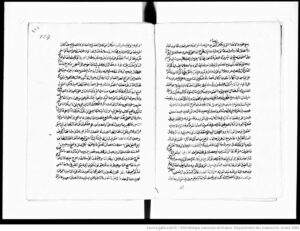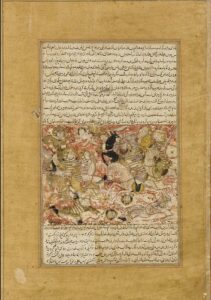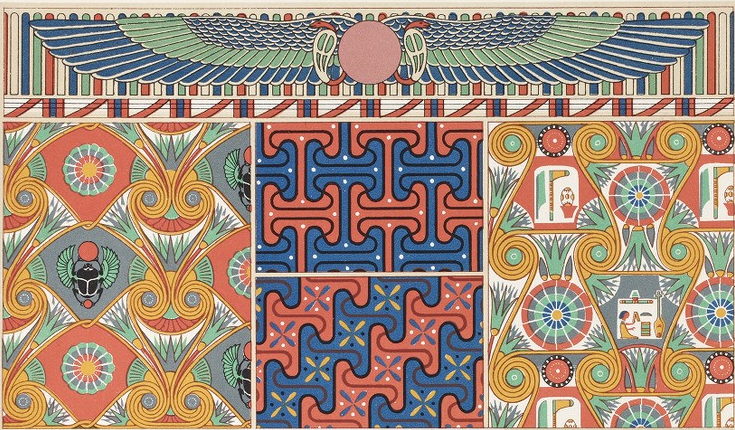When researching the revolts in Egypt from the late eighth century to the mid-ninth century, most sources we have were written in Egypt. Among the most detailed is the Kitāb al-Wulāt wa-l-Qudāt by al-Kindī. Often, these revolts are mentioned only briefly in works with an imperial perspective, like the Taʾrīkh of al-Ṭabarī or al-Yaʿqūbī. I recently found an account in al-Tanūkhī’s al-Faraj baʿd al-shidda, where a revolt serves as the backdrop for the story of a ninth-century secretary, Muḥammad b. Khalaf ibn ʿAbdūn al-Anbarī. This adab work provides interesting insights into the 829-830 revolts in Egypt, preceding Caliph al-Maʾmūn’s visit to Egypt. It offers a different perspective I’d like to share with you.
Here’s a short anecdote on how I discovered this account. While reading studies on al-Jahshiyārī’s Kitāb al-Wuzarāʾ, which survives in a unique, incomplete manuscript, I found a reference by Dominique Sourdel in Mélanges Louis Massignon (vol. III, 1957) titled “Nouvelles recherches sur la deuxième partie du ‘Livre des Vizirs’ d’al-Jahshiyārī” (pp. 271-299). In this 1954 contribution, Sourdel followed Mikhāʾīl ʿAwwād’s path (al-Qism al-ḍāʾiʿ min Kitāb al-wuzarāʾ li-l-Jahshiyārī, 1943) by gathering fragments of the second part of Kitāb al-Wuzarāʾ from later works, including Ibn al-Abbār al-Quḍāʾī’s Iʿtāb al-Kuttāb and al-Tānukhī’s Al-Faraj baʿd al-shidda.

Ms Arabe 3483, BnF, al-Faraj baʿd al-shidda
Fragment number 21, reproduced in the 1978 critical edition of al-Tanūkhī’s work by ʿAbbūd al-Shāljī (Beirut: Dār Ṣādir), comes from the Kitāb al-Wuzarāʾ and is introduced as follows: “Muḥammad b. ʿAbdūs told in the Kitāb al-Wuzarāʾ…”
The story of Ibn ʿAbdūn
In this account, Ibn ʿAbdūn narrates the story of how he met Yūsuf ibn al-Walīd al-Anbārī while walking and the latter asked him where he was coming from. He replied that he had travelled three thousand farsakhs, passing through Egypt, Fārs, Khurāsān, Khūzistān, and Azerbaijan, but noted that he hadn’t earned any money. Yūsuf asked him how much he needed (rizq), and Ibn ʿAbdūn replied that he would require fifteen dinars. Yūsuf then took Ibn ʿAbdūn to al-Faḍl ibn Marwān. Al-Faḍl is described as al-Muʿtaṣim’s kātib (secretary) when the latter was still an amīr, meaning before he became Caliph.
As a matter of fact, al-Faḍl b. Marwān was an important figure in the Abbasid administration at that time. Towards the end of the Caliphate of al-Maʾmūn, al-Faḍl b. Marwān is known to have headed the kharāj administration while serving as secretary to Abū Isḥāq. From 218–221 AH (833–836 CE), he was the Vizier of al-Muʿtaṣim and exercised great influence over the administration and its finances. In this account, after testing Ibn ʿAbdūn’s abilities to draft an appropriate reply to a designated letter, he took him into his service and gave him thirty dinars a month.
Next, another character, Ṣāliḥ b. Shīrzād, is introduced. He is known to us as a financial director in Egypt during the governorship of ʿĪsā b. Yazīd al-Jalūdī in 214 AH (829 CE), a time when Abū Isḥāq (al-Muʿtaṣim) served as the supergovernor from Baghdad. In this account, Ṣāliḥ b. Shīrzād is mentioned as a representative of al-Faḍl b. Marwān in al-Muʿtaṣim’s house. Al-Faḍl is unhappy with Ṣāliḥ’s conduct and how he manipulates al-Muʿtaṣim. Al-Faḍl expresses his wish to replace Ṣāliḥ b. Shīrzād with Ibn ʿAbdūn.
Here the story ends, and another account (khabar) starts with a transition that might be an addition of al-Tanūkhī: فَكَانَ فِي هَذَا التَّدْبِير، حَتَّى حدث أَمر القبط بِمصْر، فندب الْمَأْمُون أَخَاهُ أَبَا إِسْحَاق؛ لمحاربتهم، فِي سنة اثْنَتَيْ عشرَة وَمِائَتَيْنِ. This was the situation until the matter of the Copts in Egypt arose. Al-Ma’mūn delegated his brother Abū Isḥāq (the future al-Mu’taṣim) to fight them in the year 212 [AH]. This refers to a well-known episode of revolts in Egypt, reported by al-Kindī, al-Ṭabarī, and al-Yaʿqūbī, which forced Abū Isḥāq to step in with 4,000 Turks. In this story, al-Faḍl b. Marwān and Ibn ʿAbdūn accompanied Abū Isḥāq in his campaign. Al-Faḍl is said to have left Ṣāliḥ in the presence of al-Maʾmūn. This change directly references the end of the previous account, where al-Faḍl expressed his desire to replace Ṣāliḥ with Ibn ʿAbdūn in the proximity of al-Muʿtaṣim.

Folio 97 recto, Manuscript; Tarikhnama (Book of history) by Bal’ami, volume II; Freer Gallery of Art and Arthur M. Sackler Gallery, http://n2t.net/ark:/65665/ye30d7965cb-a511-4e8c-bde3-809002409f80
What follows offers a unique point of view on the situation in Egypt as a consequence of this revolt. While the main point seems to be showing how Ibn ʿAbdūn became rich in the service of al-Faḍl and al-Muʿtaṣim, the historical backdrop is particularly enlightening. To explain how he earned one hundred thousand dinars in one single night, Ibn ʿAbdūn mentions that ‘the killing had become widespread among the people of Egypt, the remaining inhabitants had fled, and the country was on the verge of ruin’. This situation distressed al-Maʾmūn, who ordered Abū Isḥāq to calm down the situation and to return the population to Egypt. In this context, Ibn ʿAbdūn, upon al-Faḍl’s agreement, wrote amān (letters of amnesty) for a hundred men in one night and collected money from the process.
In contrast to other narratives on this episode, which emphasise Abū Isḥāq’s suppression of the revolt and the use of violence to punish the leaders of the Qaysiyya and the Yamāniyya groups, the focus here is on the consequences of such bloodshed on the region (‘on the verge of ruin’). It also contrasts by stressing negotiation practices, such as the letters of amnesty.
Al-Tanūkhī’s Story and the 214/829-830 Revolt
In his short introduction to the text, Sourdel wrote: ‘Ce texte fournit des informations nouvelles sur la révolte du delta qui motiva l’envoie en Égypte d’Abū Ishāq et dont la répression eut lieu, selon les chroniques, au cours de l’année 214/829-30. Mais il ne s’accorde pas tout à fait avec le récit d’al-Kindī selon lequel le soulèvement, déclenché par les exactions de Ṣāliḥ b. Shīrzād alors chef du Foncier, aurait été mené principalement par les tribus Qays et Yamānīya’ (287).
We must agree that the chronology does not coincide. The event is clearly dated in the text to 212 AH, while in al-Kindī, it occurred in 214–215 AH. The other implicit discrepancies are:
- Ṣāliḥ b. Shīrzād is said to be financial director of Egypt in 214 AH and to be responsible for the outbreak of the revolt (‘he oppressed the people and raised the kharāj, whereupon the people of the Delta revolted and took up arms,’ al-Kindī, 185), while in al-Tanūkhī’s account, he seems to have no role in it.
- The “Copts” are said to be the rebels, while the other narrative sources mention Arab tribes.
The first two discrepancies (dates and Ṣāliḥ’s role) can perhaps be resolved together. One way to approach this incoherence is to distinguish between al-Tanūkhī’s purpose for including this anecdote and the accounts of the revolt found in al-Kindī.
Al-Tanūkhī’s story about Ibn ʿAbdūn is not primarily about the revolt in Egypt or the chronology of events. What seems important to him—and this is the essence of al-Faraj baʿd al-shidda—is to show how people find release from difficult situations through the generosity of others. Keeping that in mind, we understand how this story is first and foremost about Ibn ʿAbdūn and how he went from poverty to wealth by working at the service of the Abbasid administration and powerful figures. What is also important to the story is the contrast between Ibn ʿAbdūn and Ṣāliḥ b. Shīrzād. In this context, Ṣāliḥ is essential to the story of Ibn ʿAbdūn, and the fact that Ibn ʿAbdūn took his place in the proximity of Abū Isḥāq serves to illustrate his rise. However, after al-Faḍl mentions leaving him in Baghdad, Ṣāliḥ plays no further role in the story. Nonetheless, it is important that the sequence of actions is maintained for the sake of the narrative.
I would argue that Ṣāliḥ b. Shīrzād was indeed close to Abū Isḥāq, which explains how he eventually became the financial director of Egypt. We might even imagine that he was chosen by Abū Isḥāq, who was the governor of Egypt and the entire West at the time. His portrayal in this story is consistent with the idea of an oppressive financial director. When Abū Isḥāq had to intervene in 214–215 AH because the resident governors could not contain the revolt, Ṣāliḥ may have already been dismissed and returned to Baghdad, either to the Abbasid administration or close to al-Maʾmūn; we do not know for certain. But if we imagine that the event reported by al-Tanūkhī in the second part of the story actually occurred in 214 AH and not 212 AH, what is missing between both parts is the story of how al-Muʿtaṣim or al-Maʾmūn appointed Ṣāliḥ and an explanation of his role in the break of the revolt.
I believe it is no coincidence that all of these historically significant figures are mentioned together in this story: Abū Isḥāq/al-Muʿtaṣim (supergovernor of Egypt and future Caliph); al-Faḍl b. Marwān (secretary of Abū Isḥāq, who would head the kharaj toward the end of al-Maʾmūn’s caliphate and become vizier when al-Muʿtaṣim accessed the caliphate); and Ṣāliḥ b. Shīrzād (a close associate of al-Faḍl, close to Abū Isḥāq, and, at some point, financial director of Egypt). These figures are all historically linked, suggesting this anecdote is based on real events, especially considering that Ibn ʿAbdūn, as far as I can tell today, is not known to us from other sources.
The phrase, ‘This was the situation until the matter of the Copts in Egypt arose,’ contrasts sharply with what we know about this revolt from other sources. As mentioned previously, it reads to me as an added transition between two accounts that were not originally related. The revolt that chronologically follows the 829–839 events and prompted al-Maʾmūn’s journey to Egypt is said to have involved both Arabs and Copts. Thus, this apparent “mistake” might simply be the result of the vagaries of al-Tanūkhī’s knowledge of the Egyptian revolts. Another way to explain the use of “Copts” is to consider that the term may be used to refer to the whole population of Egypt, and not only the Christians. Edward Zychowicz-Coghill has convincingly shown in his research that Ibn ʿAbd al-Ḥakam distinguishes between the Copts and the Rūm, and that he attempted to reconcile the history of the Copts/indigenous people with “Islamic” history. In the context of a work composed in the East, like al-Faraj baʿd al-shidda, I wonder whether for al-Tanūkhī, “Copts” is simply a generic way to refer to the people in Egypt, regardless of their religion.
These paragraphs are part of ongoing research and reflection on the narratives of Egyptian fiscal revolts. They are primarily first thoughts that aim to be challenged and/or clarified. My aim in this blog post is to share how these unexpected narratives inform us about these revolts and about the Abbasid administration, primarily through its key actors.
This blogpost has been written by Noëmie Lucas
Banner Image: Capture of Planche II from L’Ornement polychrome. Cent planches en couleurs… contenant environ 2.000 motifs de tous les styles, art ancien et asiatique, moyen âge, Renaissance, XVIIe et XVIIIe siècles, recueil historique et pratique, publié sous la direction de M. A. Racinet,…. Volume 1, ark:/12148/bpt6k1512059w, Bibliothèque nationale de France, département Réserve des livres rares, FOL-V-5332 (1)




Leave a Reply